Research - (2021) Volume 9, Issue 8
The Effectiveness of Structured Teaching Program of Knowledge of Diabetic Foot Care among the Diabetic Patient
Lavanya S, Meena P, Asha M and AR Bharathi*
*Correspondence: AR Bharathi, Department of Nursing, Bharath Institute of Higher Education and Research, India, Email:
Abstract
Diabetes mellitus is a global emergency, some 415 million people worldwide, are estimated to have diabetes. People with diabetes are at higher risk of developing several disabling and life-threatening health problems. Diabetic foot is one of the major complications in diabetes patients, affecting around 10-15% of the patients at some point of time in their lives and accounting for nearly 50% hospital admissions among diabetics. Diabetic foot complications cause huge economic burden to the society. The only way to cut short this problem is patient education, regular foot care, early detection of contributing factors, tight blood sugar control and selection of proper footwear. More than one million people with diabetes lose a leg every year because of their condition. This means that every thirty seconds a lower limb is lost to diabetes somewhere in the world. Most of these amputations are preceded by a foot ulcer.
Keywords
Diabetes, Foot ulcer, Diabetic footIntroduction
Diabetes has become a global disease, it is fourth leading cause of death in most of the developed and developing countries, diabetes has been excesses more than 200 million this figure is predicted to reach 333 million by 2025 as a consequence of longer life expectancy, sedentary lifestyle ad changing dietary patterns.1 Diabetes is the global epidemic of 21st century, according to World Health Organization presently there are 34 million diabetes patients in India with projected increase to 79 million by 2030. World Health Organization estimated that every 5th diabetic is an Indian.2
As well as nerve damage, people with diabetes can experience problems with poor circulation to the feet, because of damage to blood vessels. These problems increase the risk of ulceration, infection, and amputation. People with diabetes face a risk of amputation that may be more than 25 times greater than that in people without diabetes. With good management however, a large proportion of amputations can be avoided. Even when a person undergoes amputation, the remaining leg and the person’s life – can be saved by good follow-up care. In view of these risks, it is important that people with diabetes examine their feet regularly. Proper foot care can reduce the chances of diabetic foot and lower limb amputation.
Diabetic foot ulcer is a result of micro and macro vascular complications in diabetics. Adoption of foot care practices to reduce the foot problems in diabetic patients. Education makes the clients to improve the knowledge and practice regarding diabetic foot care. Hence, the structured teaching programme was an effective method for providing moderate to adequate knowledge regarding diabetic foot care. If regular follow up for the foot care is adopted by the diabetic patients that can be helpful to reduce the risk of foot ulcers [1-8].
Materials and Methods
To achieve the objectives of the study a description survey approach was used to obtain a accurate and meaningful phenomena under study, the present study was concerned with the collection of information regarding knowledge level of diabetic client regarding diabetic foot care.
Dependent variable-knowledge of diabetic clientage 40 to 60yrs). The study was conducted at nandhivaram rural area. The study population comprised of only diabetic client aged 40-60yrs Target Population. The sample size consists of 25 diabetic patients living in nandhivaram rural area at the age group of40-60yrs.
Sample selection
Inclusion criteria
• Diabetic patient who was willing to participation in the study.
• Diabetic patient who can speak and understand Tamil.
• Diabetic patient who was present at the time of data collection who are between age among of40 to 60.
Exclusion criteria
• Patient with other disease.
• Patient with other age group.
Development of data collection tool
The data was collected doing 10am to 12pm from the diabetic patient, who are living in the rural area in nadhivaram, guduvancheri, questionnaires were administered, pre-test was conducted following that structured teaching program me was given and post-test was conducted to assess the knowledge on diabetic foot care. The pre-test was done by giving questionnaires after the pre-test the research administered structured teaching by using appropriate charts, models, and handouts. Structured teaching program me contains information regarding diabetic foot care. The post-test ways conducted on the same day.
Results and Discussions
Table 1 and Figures 1 to Figure 4 shows that 20% of samples belongs 40-50yrs, and 60% belongs to 51 to 60yrs.
| Demographic data | Frequency | Percentage |
|---|---|---|
| Age | ||
| 40-45yrs | 5 | 20 |
| 46-50yrs | 5 | 20 |
| 51-60yrs | 15 | 60 |
| Education | ||
| illiterate | 5 | 20 |
| High school | 18 | 72 |
| H secondary | 1 | 4 |
| Graduate | 1 | 4 |
| Sex | ||
| Male | 14 | 56 |
| Female | 11 | 44 |
| Income | ||
| 5ooo | 4 | 16 |
| 5000-10000 | 11 | 44 |
| 10000 above | 10 | 40 |
| Nutrition | ||
| vegetarian | 1 | 4 |
| non-veg | 24 | 96 |
Table 1: Frequency and percentage distribution of selected demographic variable of the samples.
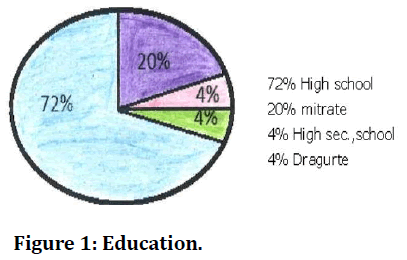
Figure 1. Education.
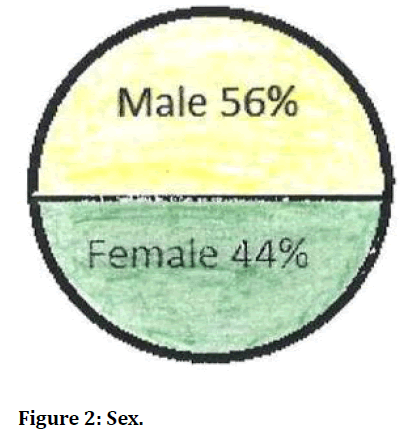
Figure 2. Sex.
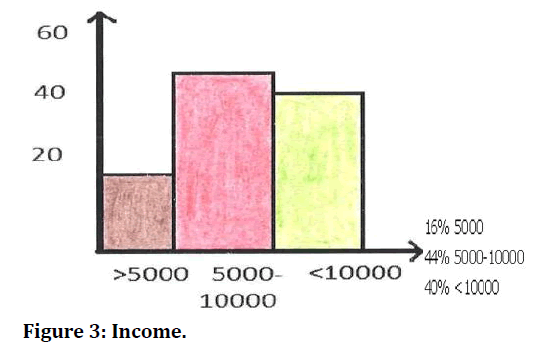
Figure 3. Income.
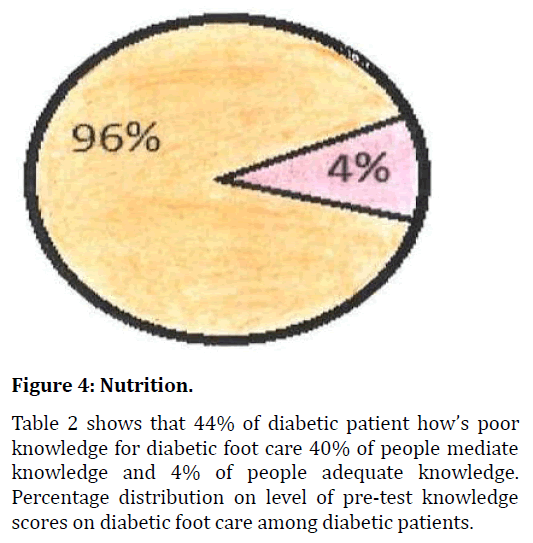
Figure 4. Nutrition.
Regarding qualification inlet rate people 20%), 72% have completed in higher education 4%) have completed higher secondary education 4% have completed graduation. 56% of samples in male and 44%> of Samples collected in female.Shows that 16% people income is 5000/monthly, 44°/o people income 5000-10000/monthly, and 40% people Salary is above 1000/monthly.
4% of people to take the vegetarian and 96% of people take most of the subject had completed high school education in 72% 2O°/o illiterate, 4% high secondary and 4% draught.
Table 2 shows that 44% of diabetic patient how’s poor knowledge for diabetic foot care 40% of people mediate knowledge and 4% of people adequate knowledge. Percentage distribution on level of pre-test knowledge scores on diabetic foot care among diabetic patients.
| Knowledge | Frequency | Percentage |
|---|---|---|
| Very poor | Nil | 0 |
| Poor | 11 | 44 |
| Mediate | 10 | 40 |
| Adequate | 4 | 6 |
Table 2: Percentage distribution on level of pre-test knowledge scores on diabetic foot care.
Table 3 shows that none have inadequate knowledge on diabetic foot care 96% of people adequate level and 4% people moderate level. percentage distribution level of post-test knowledge scores of diabetic patients on diabetic foot care.
| Knowledge | Frequency | Percentage |
|---|---|---|
| Inadequate | Nil | nil |
| Moderate | 1 | 4 |
| adequate | 24 | 96 |
Table 3: Knowledge scores.
Figure 5 reveals that in the post test, 96% of the samples had acquired adequate knowledge and 4°/o had acquired moderate knowledge and none of them had inadequate knowledge about diabetic foot care.
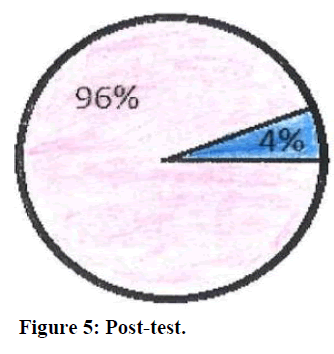
Figure 5. Post-test.
Table 4 and figure 6 shows that on comparing pretest and posttest knowledge score the knowledge level was improved adequate from 4 to 24, moderate from l0 to l and poor from l1 to nil.
| Knowledge | pre-test frequency | % | post-test frequency | % |
|---|---|---|---|---|
| very poor (0-5) | nil | nil | nil | nil |
| poor (6-10) | 11 | 44 | nil | nil |
| Moderate (11-15) | 10 | 40 | 1 | 4 |
| adequate | 4 | 6 | 24 | 96 |
Table 4: Comparing pre-test and post-test knowledge on diabetic foot care among diabetic patient.

Figure 6. Comparing pre-test and post-test knowledge on diabetic foot care among diabetic patients.
This chapter deals with the discussion of results of the data analyzed based on the objective and hypothesis of the study, the problem stated was "a study to assess the effectiveness of structured teaching program me on knowledge of diabetic foot care among diabetic patient living in nandhivarsam rural area. A total number of 25 sample were sleeted for the study and the study was conducted by using structure teaching programme.
Before the structured teaching Program, me the pre -test was conducted for 25 diabetic patients. Data analysis showed that 11(44%) have poor knowledge for diabetic foot care 10(40%) of people moderate knowledge and 4% of people adequate knowledge.
To assess the knowledge on diabetic foot care among diabetic patient after administering a structured teaching programme. After the structured teaching programme, a post-test data analysis showed that non have inadequate knowledge on diabetic foot care 24(96%) of people adequate s C iff levels of knowledge and 1(4%) of people moderate levels of knowledge.
On comparing pre-test and post-test knowledge scores 44% of poor knowledge in pre-test, post-test show none of them have poor knowledge. 40% of moderate knowledge in pre-test and 4% moderate knowledge in post-test and"6% of adequate knowledge in pre-test 96% of adequate knowledge in post-test.
Conclusion
The following conclusions were made from the study findings. The structured teaching program me given to the study showed group improvement the knowledge level on diabetic foot care, it is highly significant.
Funding
No funding sources.
Ethical Approval
The study was approved by the Institutional Ethics Committee.
Conflict of Interest
The authors declare no conflict of interest.
Acknowledegements
The encouragement and support from Bharath Institute of Higher Education and Research, Chengalpattu, Tamil Nadu, India is gratefully acknowledged for providing the laboratory facilities to carry out the research work.
References
- Lippincott. A text book of medical surgical nursing. 11th Edn.
- Brunner. A text book of medical surgical nursing. 1st Edn.
- Louis. A text book of medical surgical nursing levels.
- International Diabetic Federation Atlas. 6th Edn 2013.
- Boulton A. The diabetic foot: Epidemiology, risk factors and the status of care. Diabetes Voice 2013; 50:1-6.
- Diabetes and Foot Care. A joint publication of the International Diabetes Federation and the International Working Group on the Diabetic Foot 2013.
- Reiber GE, Vileikyte L, Boyko EJ, et al. Causal pathways for incident lower extremity ulcers in patients with diabetes from two settings. Diabetes Care 1999; 22:157–162.
- Macfarlane RM, Jeffcoate WJ. Factors contributing to the presentation of diabetic foot ulcers. Diabet Med 1997; 14:867–870.
Author Info
Lavanya S, Meena P, Asha M and AR Bharathi*
Department of Nursing, Bharath Institute of Higher Education and Research, Selaiyur, Chennai-600073 Tamil Nadu, IndiaCitation: Lavanya S, Meena P, Asha M, AR Bharati, The Effectiveness of Structured Teaching Program of Knowledge of Diabetic Foot Care among the Diabetic Patient, J Res Med Dent Sci, 2021, 9(8): 72-76
Received: 17-Jul-2021 Accepted: 02-Aug-2021
